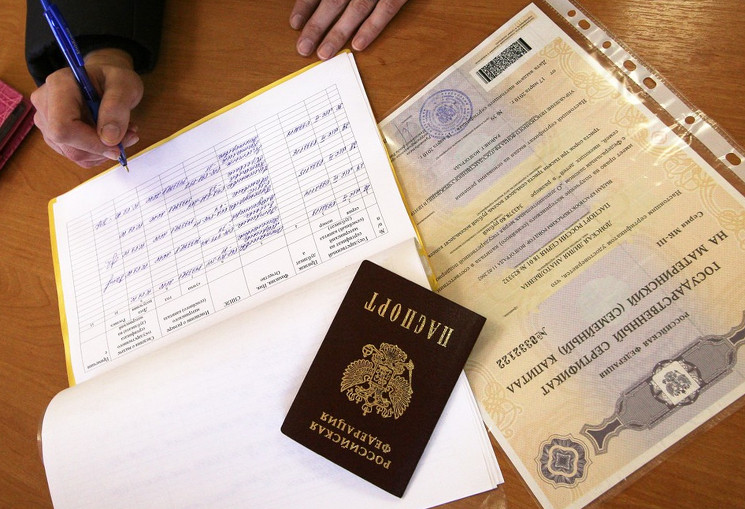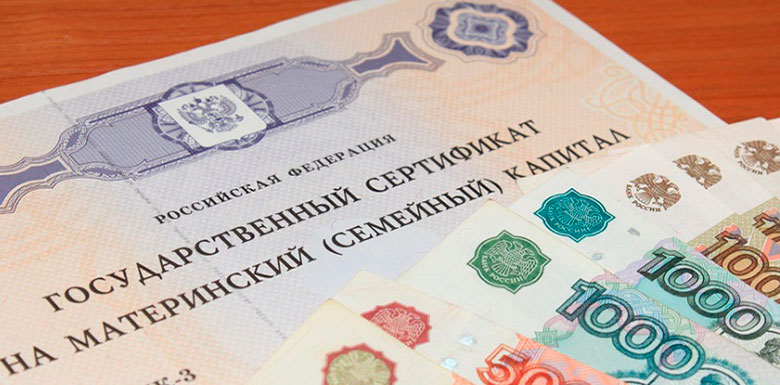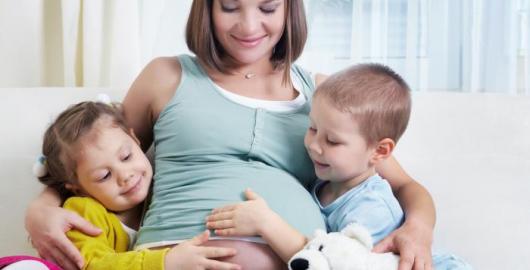For the modern average Russian family, the birth of a third child is very rare. Nowadays there are a small number of families that have more than two children.
First of all, the reason is an unstable financial situation, so many parents, after the birth of their first child, do not even want to think about a second baby.
The state accommodates families with three or more children and offers various payments and social programs that can somewhat improve the financial situation of the family.
Payments for the birth of a third child are as follows:
- If the mother registered at the very minimum stage of pregnancy, then she is entitled to a lump sum benefit for the birth of a child.
- . These payments can be received by women who were officially employed before pregnancy. The amount of this benefit is the average salary for the last two years labor activity. Paid in one lump sum.
- At the birth of the third baby, the mother has the right to receive a lump sum payment in the amount of 13,741.99 rubles.
- A woman who has three or more children and is in maternity leave for caring for a newborn, until the child reaches the age of 1.5 years, receives monthly allowance, which is about 40% of her average salary.
- An additional benefit that is paid every month until the child reaches three years of age. Its size corresponds to the minimum subsistence level, which is established in the region of residence of the mother.
- Certificate for receiving maternity capital. But you can receive this amount of money only if you did not receive this certificate after the birth of your second child.
In some regions, regional payments for children may be additionally established on a monthly basis.
One-time benefit
At the birth of the third child, one of the parents is provided lump sum payment. In 2015, the amount of this benefit is 14,497.80 rubles.
There are a number of regions, for example, the Far North, where the amount of benefits increases by an index that is established in a given region.
The benefit is not due if the child is stillborn.
If the recipient of the benefit is a working person with official employment, then the benefit is paid at the place of his work activity.
If a person does not have a job or is a full-time student, then the benefit will be paid by the Social Insurance Fund at the place of registration. The benefit of both spouses is received by the one who is officially employed.
In order to receive a one-time payment from the state, you must:
 At the birth of a third child, a one-time payment in the amount of 14,497.80 rubles is provided
At the birth of a third child, a one-time payment in the amount of 14,497.80 rubles is provided - application for child support
- birth document of the child(ren)
- document at the place of work of the second spouse confirming that he does not receive benefits
- extract from the last place of work (work book). But this is only if the benefits are paid by the authorities social protection
- in case of divorce between the parents of a born child - a document that confirms this fact.
All documents must be submitted within six months from the date of birth of the baby.
The benefit is assigned within 10 days from the date of submission of documents.
The employer is obliged to pay the assigned amount within ten days from the date of its assignment. If funds are paid by social security authorities, the payment period is 26 calendar days from the date of assignment.
Monthly allowance
The minimum amount of benefit for caring for a third child in 2015 is 5,153 rubles for parents who are unemployed.
For working citizens minimum size is 7000 rubles.
In different regions of the country, this indicator may have different values, but it can only change in big side, below the established minimum, regional authorities do not have the right to pay benefits. Maximum size payments amount to 12,000 rubles.
In order for parents to take advantage of this monthly benefit, they must contact the social security authorities at their place of residence with the following documents:

It should be noted that the benefit for the third child, which will be paid monthly, can be received if a similar benefit was not paid for the second child. Therefore, all documents must be accompanied by a certificate confirming this fact.
If the child’s parents are officially employed, then they need to apply with all these documents to their place of work.
Maternity capital
Another payment that is due to the third child is maternity capital.
Among all the benefits and payments that are prescribed by the state in connection with the birth of a child, maternity capital is the most significant payment, which currently amounts to 453,026 rubles.
This is an excellent opportunity for young families with children, since this is the direction of using maternity capital funds that is the most popular in our country.
Maternity capital is issued not as a sum of money, but in the form of a certificate with subsequent crediting of funds to a bank account.
Maternity capital for a third child is issued only if a number of conditions are met:
- one of the parents must have Russian citizenship
- after the birth of the second child it was not registered, and none of the family members received it
- second or third child born after January 1, 2007
- The child's parents should not be deprived of parental rights.
At the birth of a third child, the state provides the family with various payments and benefits that can somewhat improve the financial situation in the family. After all, three children for a modern person is, one might say, a real feat.
In addition to one-time payments, older children and large families are also entitled to a number of benefits when enrolling in preschool and school educational institutions, vocational schools.
This video will tell you about the payments provided at the birth of a third child:
Write your question in the form below Attention, TODAY only!
Category: Pen stroke 03
Today, state assistance in the form of payments at birth, as well as monthly benefits, are a significant help to the family budget of young families. The state plans to spend 408.9 billion rubles for these purposes in 2017.
Payments upon birth of a child
Now there is a one-time payment at the birth of a child. The amount depends on the mother’s financial situation for the last two years before maternity leave. Payments are accrued within ten days after submitting documents. Women can receive money before maternity leave at their place of work. Unemployed people and students can count on a minimum benefit.
At the birth of the 3rd child, receiving lump sum benefit perhaps one of the parents. Now the benefit amount is 14 thousand 497.8 rubles. Payments are made at the place of work of one of the parents. The indexation of this amount in 17 will become known after the adoption of the budget.
The monthly allowance for a third child up to one and a half years is 40% of average earnings for the last 2 years. Currently, the smallest benefit is 5 thousand 436.67 rubles. All relatives caring for the baby can receive this payment. Payments are made at the applicant's place of work. In some regions of Russia, individual monthly benefits are provided for up to 3 years. Their amount is usually measured according to the cost of living adopted in the current year in the area. In 53 constituent entities of the Russian Federation, such benefits come from the national budget, and in sixteen - from regional revenues. In some of them, such payments are not made, because they do not see the need for them. The list of subjects is established by the Russian government.
In addition, each region provides for other measures to support the birth rate. More information about what you can expect when a child is born in a particular region can be found in the social protection authorities at your place of residence.
What awaits maternity capital in 2017
This program to help large families began operating in 2007 and about 5 million Russian young families took advantage of it. Over 9 years, about 720 million rubles were spent on assistance. This benefit has a specific purpose. Money can be spent on:
- improving living conditions for the child;
- child education;
- mother's pension.
Parents have the right to MK at the birth of their second child, as well as upon adoption. The parents of the third child can use the money if for some reason they did not receive it at the birth of the second.
According to official data, the assistance program should end on January 1, 2017, so many young families are confused and do not know whether they can expect help from the state. The program has shown its effectiveness in recent years. It was approved by Russian society and supported by the majority of State Duma deputies.
At the same time, the deteriorating economic situation in the country raises concerns among the population about maternity capital. In this regard, several assumptions can be made regarding the development of events.
- The subsidy could be extended until 2027 if the state finds additional funds to support young families. In addition, the benefit may increase to 1.5 million rubles, and parents will be able to receive such amounts at the birth or adoption of a third child. This proposal was made by State Duma deputies from the Belgorod region of the Russian Federation. It was also proposed to change the scope of application of the MK and not to index the benefit in accordance with inflation. Aid will become fixed and targeted.
- The program will be extended if it is significantly adjusted. The President of Russia spoke on this matter. Families with low income will receive assistance. Parents who earn enough money may lose government assistance. Thus, the project will become targeted.
- The law can be stopped at a strictly specified time, and the following measures will be used to reassure the population:
- they will double child benefits, according to the Minister of Finance - the best option;
- per visit preschool institutions compensation will be increased.
To summarize, we can say that the current payments for the 2nd and 3rd children are still in question. 2017 will be a time of anticipation for news for young families.

Benefits for large families
A family in which a 3rd child is born is assigned the status of a large one, which gives the right to a number of benefits:
- kindergarten without waiting list;
- medicines up to six years free;
- free school uniform;
- free food;
- travel to school years for free;
- obtaining land for building a house;
- utilities are 30% cheaper.
- preferential transport tax(in certain regions).
In 2015, the State Duma discussed a bill on the possibility of paying 1.5 million rubles. in favor of families in which a third child is born after 2017. The bill assumed that maternity capital would be allocated to families with 3 children and subsequent children (or if they adopt a child) up to 2026.
Conditions for receiving maternity capital
This bill had a long history. It was introduced for discussion by Belgorod deputies back in 2014. But they began to consider it only in 2015.
Maternity capital 1.5 million rubles. cannot be cashed and can be used at your own discretion. It was assumed that the funds could be used to improve living conditions.
This bill has generated widespread interest among Russian families who were planning a third child and they were eagerly awaiting the decision of the State Duma.
Size and order of registration
At the moment, the family capital program continues to operate in Russia. It gained wide popularity among the population and allowed millions of Russian families to acquire their own housing.
 Over 6 million people have already received family capital. and the majority (more than 95%) they preferred to use it to improve living conditions. Other areas of potential use of the certificate are less popular: teaching children.
Over 6 million people have already received family capital. and the majority (more than 95%) they preferred to use it to improve living conditions. Other areas of potential use of the certificate are less popular: teaching children.
The government has already spent over 750 billion rubles on payments on certificates.
Maternity capital has been in effect since 2007 and its value is indexed annually. Thus, initially maternity capital amounted to 250 thousand rubles, then it was indexed annually and by 2016 it amounted to 453 thousand rubles. In 2016, for the first time, the cost of the certificate was not indexed and it remained at the 2015 level.
The bill, which provided for payments of 1.5 million rubles, did not include indexation of the specified amount. Those. for 10 years, despite inflation, the family was entitled to 1.5 million rubles.
Unfortunately, for a large number of families, the bill on one and a half million payments was rejected in the first reading. The deputies motivated their decision by the fact that it discredits families who will have a third child before 2017 (they will receive only 453 thousand rubles, and not 1.5 million rubles).
This is the official reason, but many experts believe that the Government simply did not have the funds to implement the project in the current difficult conditions.
Upon the birth of a third child, a family receives the status of a large family, which gives it the right to receive a number of cash benefits and additional benefits. Thus, a woman has the right to receive all payments due upon the birth of children. This maternity benefits (paid only to officially employed women, taking into account their average earnings over the last 2 years), one-time payment (this is 15,295 rubles in 2016) and other payments provided by the regions.

In some regions, in addition to federal maternity capital, there is also their own regional capital, which is issued at the birth of the third child. The amount of such payment is up to 50-150 thousand rubles.
For the 3rd child, a woman is entitled to a monthly benefit for up to 1.5 years. Its minimum size is 5.7 thousand rubles, the maximum is 21.6 thousand rubles. depending on the woman’s monthly earnings.
Low-income families are entitled to child benefits up to 16 years of age. Their size is 500-1500 rubles.
The appearance of a third child in a family provides the right to certain privileges:
- Registration for kindergarten without a queue;
- these are free medications for up to 6 years;
- free meals and transportation for schoolchildren;
- providing uniforms;
- registration of a subsidy for payment of housing and communal services up to 30%;
- receiving a free plot of land (in some regions);
- benefits for motorists to pay transport tax.
 In 2015, V. Putin signed a decree extending the maternity capital program until 2018 (inclusive) Your voices are very important and allow us to truly identify useful materials, interesting to a wide range of people.
In 2015, V. Putin signed a decree extending the maternity capital program until 2018 (inclusive) Your voices are very important and allow us to truly identify useful materials, interesting to a wide range of people.
Don't forget to rate publications and share your opinion with other project participants.



